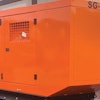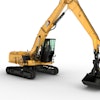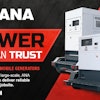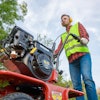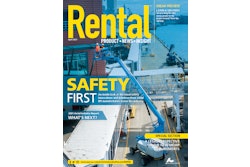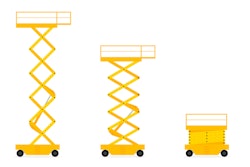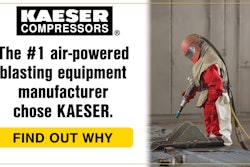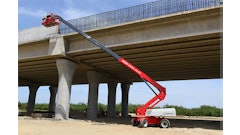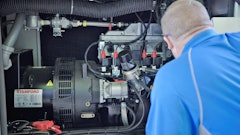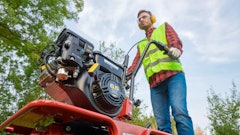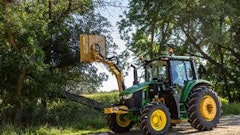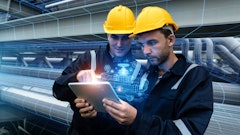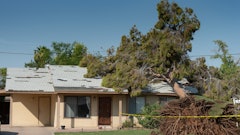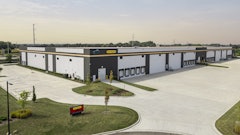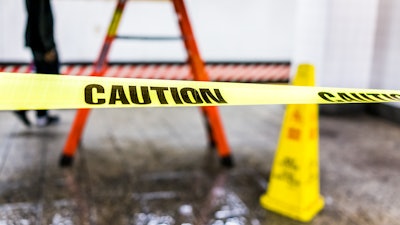
Aerial lifts are having a moment.
Not only have they started to replace ladders and scaffolding on jobsites everywhere, but they’ve also garnered attention due to their mobility, flexibility, and adaptability. With a variety of options to choose from, including boom lifts, scissor lifts, and telehandlers, they’re suitable for any size project in close to any work environment.
However, the use of aerial lifts comes with a unique sense of dangers. Common hazards like electric shock due to close proximity to power lines, falls or ejections from the basket, machine tip-overs, objects falling from the lift itself, or structural failure can all lead to injury or even death.
One of the most serious of these hazards is falls from elevation. According to OSHA, fatalities caused by these accidents continue to be a leading cause of death, accounting for 320 of the 1,008 occupational construction fatalities recorded in 2018. To help combat this epidemic, OSHA holds the National Safety Stand-Down week each year to raise fall hazard awareness in an effort to stop fatalities and injuries. This year, the event will take place in early May.
A Safety Stand-Down is a voluntary event for employers to talk directly to their employees about safety and reinforcing the importance of fall prevention. Rental business owners can conduct one by having a toolbox talk with employees, conducting safety equipment inspections, developing rescue plans to show renters, and discussing job specific hazards. Though fall prevention is an incredibly important topic, promoting safe operation and avoiding any precarious behavior in general is as equally so. This is why proper training is necessary for anyone using aerial work platforms. It’s also important for rental business owners to create awareness around common hazards before renting out these pieces of equipment to their customers.
On top of proper training, aerial lift manufacturers have taken extra steps to promote safe practices and initiatives, while also working to make their equipment even more safe for the jobsite. Today’s aerial lifts provide features that accentuate safe operation, stability, and support, such as slip-resistant surfaces, high guard rails, harnesses and lanyards, and machine tracking and telematics systems. Some have even stepped up and created initiatives to draw attention to common equipment and jobsite hazards.
We spoke with a few aerial lift manufacturers from across the industry about their safety practices, initiatives, and equipment features. Though they all have multiple examples to choose from, we asked them to only pick one to focus on to find out how they directly affect rental business owners, while promoting a safer work environment.
Genie
No matter what size your company is or how diverse your fleet is, equipment management is something rental business owners do every day. A solution to common problems, telematics has been an evolving technology in the aerial lift industry, helping to maximize productivity and minimize downtime.
 Genie released their own telematics platform, called Genie Lift Connect, which provides fleet and service managers tools to support fleets properly.Genie
Genie released their own telematics platform, called Genie Lift Connect, which provides fleet and service managers tools to support fleets properly.Genie
Earlier this year, Genie unveiled a new add-on feature to Lift Connect called Access Manager, which gives rental companies the option to remotely manage access to their fleet. The program assigns a unique code that can either be randomly generated or personally selected, like an ATM pin code, to an individual operator through the Lift Connect portal. That operator can then be assigned to specific equipment, ensuring that only authorized operators can operate the machine.
In a press release from the company, Christine Zeznick, Genie director of product and business development, Telematics, Terex AWP, said, “Not only does this provide greater security for equipment, it also can help ensure only trained operators have codes.”
Separate from Access Manager, Genie also announced the Remote Disable functionality, where equipment owners can remotely disable or enable operation of their equipment through the Lift Connect portal.
Haulotte
 When visibility is reduced, the twilight sensor automatically activates the Haulotte Activ' Lighting System.Haulotte
When visibility is reduced, the twilight sensor automatically activates the Haulotte Activ' Lighting System.Haulotte
When visibility is reduced, the twilight sensor automatically activates the Haulotte Activ' Lighting System. With a minimum of 10 LED lighting points placed around the machine, the operator can safely access, accurately control, and identify obstacles and edges clearly in the working area. According to Haulotte, all headlights and lighting points are installed on the machine in such a way as to avoid any risk of operator glare, offering increased visibility of both the environment and controls.
Hy-Brid Lifts
 The company’s goal, both with message and equipment, is to reduce falls from ladders, using what they call a “Ladders Last” mentality.Hy-Brid Lifts website
The company’s goal, both with message and equipment, is to reduce falls from ladders, using what they call a “Ladders Last” mentality.Hy-Brid Lifts website
With this campaign, Hy-Brid Lifts promotes the benefits of lifts, including their safety, productivity, mobility, and more. Features like height versatility, reducing user fatigue by eliminating repetitive climbing of ladder rungs, more platform workspace for tools and materials, and easy drawer access combine to show why lifts are the safer option for jobsites. And not just that, but time management is a huge consideration, as using ladders last eliminates the time necessary to set up ladders, can reduce the time it takes to complete a task, and makes handling materials easier.
Providing renters and contractors with more efficient ladder-less solutions, and promoting a campaign like “Ladders Last,” can help them rethink how they complete tasks and staying safer while working at height.
“A company’s risk of a serious workplace injury increases every time an employee climbs a ladder," says Justin Kissinger, VP of marketing for Hy-Brid Lifts by Custom Equipment. "‘Ladders last’ is meant to help shift employee mindset and encourage choosing safer alternatives for working at height when possible. Rental centers have the opportunity to help bridge a safety gap for contractors and communicate the unmatched efficiency and safety gained through lifts without requiring an intimidating, long-term investment."
He continues, "Although contractors may pay more up front for a lift, the savings of finishing a job weeks ahead of schedule and reducing injury risk and workman’s comp claims pays them back significantly more than an economically priced ladder.”
JLG
 JLG published a whitepaper, called "5 Steps to Reach Zero Falls From a Ladder at Work."JLG
JLG published a whitepaper, called "5 Steps to Reach Zero Falls From a Ladder at Work."JLG
In it, JLG highlights how Oshkosh Corporation and its brands have been working towards eliminating falls from ladders at work and on jobsites in a proactive pursuit of the highest level of OSHA’s Voluntary Protection Program (VPP).
“Jobsite safety has always been a core pillar at JLG, “says Jennifer Stiansen, director of marketing, JLG. “With falls from ladders being a core contributor to jobsite incidents, it is important that JLG supports industry initiatives that bolster education and awareness around implementing safety practices and safe use.”
According to Stiansen, one JLG low-leve access lift could replace multiple ladders from 5-feet up to 20-feet on any given jobsite, creating a new revenue stream for rental companies who might not already offer them. The company will continue to work towards touting safer alternatives to ladders and keeping the industry safer through the reduced risk of falls and overuse injuries.
LGMG
 A QR code is included on every machine, scannable with smartphones, which allows LGMG’s system to accurately track the machine via internal procedures.LGMG
A QR code is included on every machine, scannable with smartphones, which allows LGMG’s system to accurately track the machine via internal procedures.LGMG
The company has accomplished that vision with QR codes. A QR code is included on every machine, scannable with smartphones, which allows LGMG’s system to accurately track the machine via internal procedures, and also puts information right at the customer’s fingertips.
By scanning the code, the user is taken to all pertinent information such as spec sheets, operation manuals, service manuals, and a parts catalog. LGMG believes that users having access to this information as fast as possible makes their machines safer if there is an issue and helps get it resolved faster.
Magni America
A safety concern regularly mentioned throughout the aerial lift industry is lift capacity and making sure the machine is not being overloaded with operators, equipment, and materials.
 Magni Americas’ telescopic handlers come standard with a load moment indicator (LMI) system that prevents overloading and inhibits operators from putting machines in an unsafe position.MAGNI
Magni Americas’ telescopic handlers come standard with a load moment indicator (LMI) system that prevents overloading and inhibits operators from putting machines in an unsafe position.MAGNI
There are lots of attachment options available for Magni rotating telehandlers including forks, jibs, hooks, winches, and more. RFID tags on each attachment automatically pair with the Magni’s advanced computer system, bringing up the correct load chart for each attachment. So, no matter what attachment is on the end of the boom, operators can feel confident that they know the machine's limits and operate safely and efficiently.
Sinoboom
 Before operating a MEWP, a pre-inspection of the unit for excessive rust, corrosion, or oxidation is required.Sinoboom
Before operating a MEWP, a pre-inspection of the unit for excessive rust, corrosion, or oxidation is required.Sinoboom
Before operating a MEWP, a pre-inspection of the unit for excessive rust, corrosion, or oxidation is required. Having seen issues with poor paint quality on MEWPs, Sinoboom invested in a paint application technique for their scissor lifts similar to those seen on high-end luxury car steel components. The results show less corrosion on Sinoboom scissor lifts than competitor models, and the paint cleans up easier, making the unit quickly ready for its next rental.
Most manufacturers use electrophoretic painting, sometimes called e-coat, for painting metal surfaces. The process involves immersing the part in a wet paint that uses an electrical current to attract the paint product to a metal surface. Many variables affect whether the coating lasts or if it begins to chip right away, including the quality of paint and the preparation of the parts before e-coating. Sinoboom’s unique process of using a specific pigment paint mix, combined with an extreme temperature oven to cure the paint, has led to less rust and corrosion over time.
Skyjack
 Skyjack implemented design changes that go beyond standards and further contribute to proper on-site machine use.Skyjack
Skyjack implemented design changes that go beyond standards and further contribute to proper on-site machine use.Skyjack
In addition to the safety-related changes outlined by ANSI, Skyjack also implemented design changes that go beyond standards and further contribute to proper on-site machine use. Secondary Guarding Electrical (SGE) is a standard feature on booms, which includes a sensor bar that instantly stops all functions when pushed against and initiates an audible siren and light beacon. If pressure is applied to the bar for more than one second the engine will also stop, which halts all regular functions until reset. The emergency lowering controls can still be operated to bring the platform safely to the ground.
An example of an optional enhancement to this feature is the Secondary Guarding Lift Enable (SGLE). For use on vertical masts and scissor lifts, it’s designed so the machine only lifts when both the joystick enable and tamper-proof secondary enable button are activated. The release of either of these switches will stop lifting functions immediately. An added benefit is that it keeps the operator’s body in an upright position and away from railings, which mitigates the risk of entrapment.
Snorkel
 Snorkel Guard is a simple, mechanical secondary guarding system that is fitted as standard to all factory-built Snorkel boom lifts.Snorkel
Snorkel Guard is a simple, mechanical secondary guarding system that is fitted as standard to all factory-built Snorkel boom lifts.Snorkel
Snorkel Guard is a simple, mechanical secondary guarding system that is fitted as standard to all factory-built Snorkel boom lifts. It features a spring-loaded rail that sits above the upper control panel that cuts out machine operations when compressed. When Snorkel Guard is activated, the horn is sounded and a flashing blue light on the platform is illuminated. Whenever the system is activated, the platform can be lowered from the ground using the selector switch to enable the lower control panel.
Matthew Elvin, CEO of Snorkel, said, “The value of Snorkel Guard to a rental business owner is that, in addition to providing their customers with an additional level of protection while using the lift, the Snorkel Guard design does not interfere with normal lift operation and does not have any complicated electronics, which potentially lead to increased service calls.”

